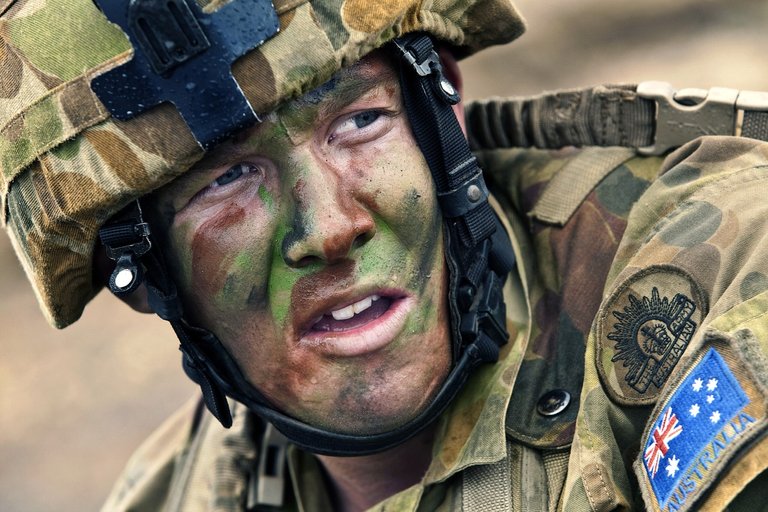
#Camouflage paint for your skin is a common camouflage aid. Of course, there are corresponding products in the specialized trade for weapons or hunting needs. We’ll show you how to make your own camouflage colors for a fraction of the price.
What camouflage paint is:
In essence, camouflage paint is a more or less viscous paste, consisting of carrier material and the desired pigments. Nothing else. The classic camouflage colors green, brown, black and black are in common use.
Preparing for SHTF events is often costly enough. But even in times of crisis, it helps to know the possibilities, to be able to create things easily, inexpensively and without much effort.
How to make camouflage paint?
As already mentioned, camouflage paint is only a carrier material and color-matching “pigments”. And “pigments” are nothing but small, fine colored particles.
The carrier material:
Suitable carrier materials are fatty substances. Petroleum jelly has proved to be suitable for me personally. Petroleum jelly is cheap and easily available in supermarkets or pharmacies. It’s already very suitable in its consistency and is generally used for skin care, which I have no concerns about applying it to my skin.
Petroleum jelly is also a very suitable fuel. If I have camouflage paint from Petroleum jelly, I can do without extra Petroleum jelly as a fire accelerator. Basically, you can think of other things: Why not stain the reliable fire accelerator Petroleum jelly and thus expand functionally?
You should avoid smelly materials. Camouflage is also a thing of odor! And you should test a small amount on your skin for real time, before you have to use it!
The pigments:
Any relevant color is easy to produce, with the things that you have in the household or directly outside the house or in the field.
Besch: Naturally pulverized soil is works great. Saw dust can also be used. Note: some halters contain essential oils. These ails could cause skin irritation in sensitive mesms. Think about: besch (and other) colors often darken a little bit, if the get wet or fatty.
Black: Charcoal is of course available. Cheap or #free and easy to organize.
Brown: Finely ground coffee or similar colored earths are the means of choice.
Green: can be easily made from dried and powdered tea leaves. Differently crushed plant material should also work in an emergency. Normally, however, plant material will become brown when dried. Tea stays green through the process of fermentation.
White: wood ash. Thoroughly burned wood leaves light gray, almost white ash. Wood leaves more ash than charcoal. This fine ash is free and easy to create.
Production:
The materials of the desired color should be minced as finely as possible. A mortar is a good choice. Or you can rub the stuff between two flat stones. If the pigments are fine enough, the petroleum jelly may be mixed with the pigments. Normally only small amounts of pigments are necessary. So mix it in step by step, if you add pigments to the petroleum jelly. As a test, you can apply the mixture on the back of your hand.
By adding the dry powder, the consistency of petroleum jelly gradually solidifies. You may want to add a small amount of (low-odor) cooking oil.
Is the paste according to the ideas, I press it in a small plastic box, something similar to the film cans for films for analogue cameras. The important thing is: the container should be stable, easy to close and not break or open when pressed. I found these containers in plastic boxes, in which textile dye is sold. Here the lids are even colored accordingly.
For small quantities, the plastic capsules for contact lenses are very good. These are stable and often divided into several small separate chambers.
Tubers tend to be less susceptible because they are more sensitive to pressure and the packaging is often less firm. When pressing on the flexible tube, the lid can be easily pushed open or burst the tube.
Storage:
It is advantageous that smaller quantities can be produced with this recipe. Although the petroleum jelly preserves in some ways: in the paste are organic ingredients. This could change, possibly even mold. With mold I had never had any problems with earth, tea, coffee or coal.
I always kept small containers of paint (for contact lenses, as an example) in my regular equipment. This amount is usually sufficient for the fast need in most situations.
Larger containers like the cans I do not always carry on the man. Since I do not need these cans on a daily basis, store them in a cool place, rather than the fridge, and only be taken out and put in the luggage when I know I need them.
Greetings!

Hey @steem-untalented. Would you like to give me a small upvote? I would be very happy!
@originalworks, what's going on? I would like to see you here!
Yeah @originalworks, save this content and vote for it ;) :*
:-*
kill all zombies !